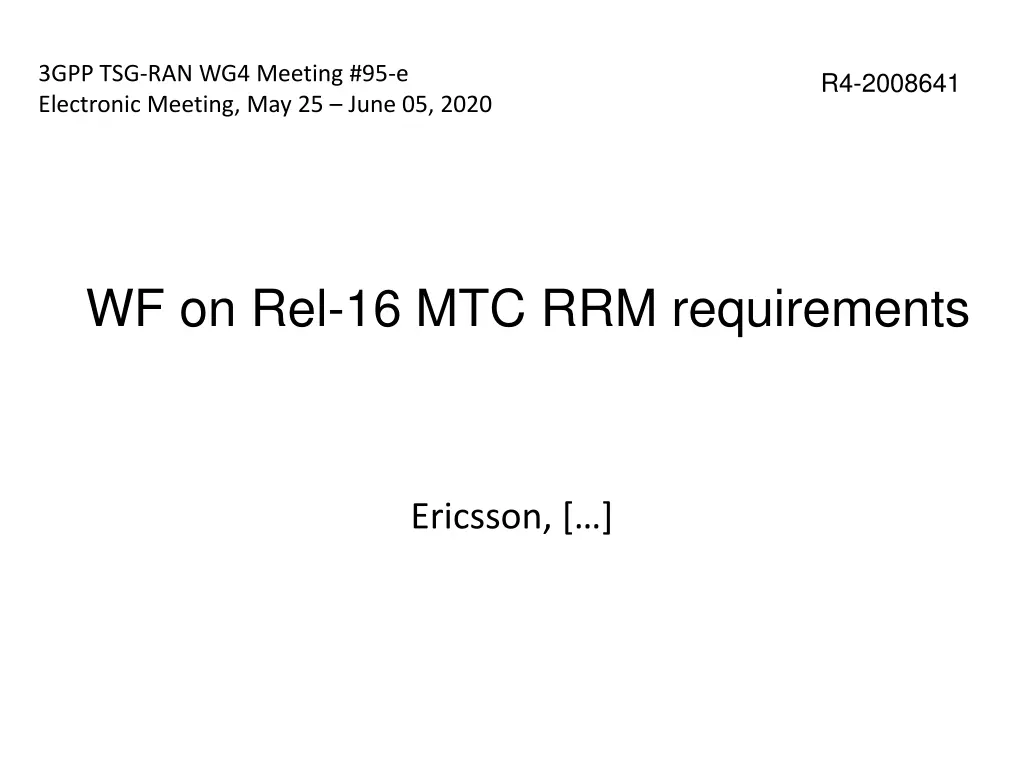
Mobility Enhancement and RSS-Based Measurement for 3GPP TSG-RAN Meeting #95-e
Explore mobility enhancements using RSS-based RSRP measurements for UE's idle and connected modes discussed at the 3GPP TSG-RAN WG4 Meeting #95-e regarding MTC RRM requirements for Rel-16. The requirements include preconfigured UL resources and signaling capabilities for neighbor cell measurements, aiming to improve UE synchronization and measurement functionalities.
Download Presentation

Please find below an Image/Link to download the presentation.
The content on the website is provided AS IS for your information and personal use only. It may not be sold, licensed, or shared on other websites without obtaining consent from the author. If you encounter any issues during the download, it is possible that the publisher has removed the file from their server.
You are allowed to download the files provided on this website for personal or commercial use, subject to the condition that they are used lawfully. All files are the property of their respective owners.
The content on the website is provided AS IS for your information and personal use only. It may not be sold, licensed, or shared on other websites without obtaining consent from the author.
E N D
Presentation Transcript
3GPP TSG-RAN WG4 Meeting #95-e Electronic Meeting, May 25 June 05, 2020 R4-2008641 WF on Rel-16 MTC RRM requirements Ericsson, [ ]
Preconfigured UL resource Do not specify the exact time duration for synchronization and Tserach times for normal DRX and eDRX, instead it is stated that the UE shall be synchronized towards the serving cell prior to the transmission, and otherwise UE shall not transmit (drop or postpone).
Mobility enhancement: RSS based RSRP measurement for UEs IDLE mode neighbour cell measurement conditions Introduce capability signaling to indicate whether the UE is able to measure on neighbor cell RSS that is in the same NB that UE monitors. Minimum/maximum distance: Minimum distance: 0 ms Maximum distance: 4 ms Neighbour cell measurements is done before the paging occasion Indicate in LTE feature list about capability indicating whether the UE is able to measure on neighbour cell RSS that is in the same NB that UE monitors.
Mobility enhancement: RSS based RSRP measurement for UEs CONNECTED mode serving measurement conditions serving cell RSS share the same NB as that of paging MPDCCH for successive N DRX cycles, RSS power offset with respect to CRS is equal to or greater than 0 dB, RSS time location of the cell being measured does not coincide with UE s measurement gap (if configured) Minimum/maximum distance: Minimum distance: 0 ms Maximum distance: 4 ms RSS-based measurement period is not longer than CRS-based measurement period.
Mobility enhancement: RSS based RSRP measurement for UEs CONNECTED mode neighbour cell measurement conditions RSS frequency location of the cell being measured occurs in the NB(s) that UE monitors for MPDDCH for the N number of samples RSS time location of the cell being measured does not coincide with UE s measurement gap (if configured) RSS power offset of the cell being measured is not sRSS location in frequency with respect to measured neighbor cell: Follow the similar agreement from IDLE mode Minimum/maximum distance: Follow the similar agreement from IDLE mode
Mobility enhancement: RSS based RSRP measurement for UEs Measurement delays in IDLE mode RSS-based measurement period is not longer than CRS-based measurement period. Delay is expressed in terms of Tmeasure and Tevaluate Measurement delays in CONNECTED mode TRSS=160 ms, L1 measurement period is 480 ms and 800 ms in normal and enhanced coverage respectively for BL and non-BL UEs in non-DRX. If TRSS=320 ms, L1 measurement period is 960 ms and 1600 ms in normal and enhanced coverage respectively for BL and non-BL UEs in non-DRX. L1 measurement period is defined as max (DRX cycle length, TRSS) x 3 in normal coverage in DRX. L1 measurement period is defined as max (DRX cycle length, TRSS) x 5 in enhanced coverage in DRX.
Mobility enhancement: RSS based RSRP measurement for UEs Concurrent CRS and RSS measurements The UE is not expected to measure on both RSS and CRS for RSRP measurements. In idle mode, UE is not required to concurrently measure based on RSS and CRS. UE is required to meet the current CRS based requirements for cells which cannot be measured based on RSS. UE is not required to measure both CRS and RSS for the same serving or neighbour cell.
DL quality reporting Use the same 2-bit report mapping from Rel- 14 NB-IoT for eMTC. RAN4 reuse the downlink channel quality measurement report mapping of CQI- NPDCCH-Short-NB for eMTC short downlink channel quality report in MAC CE.
